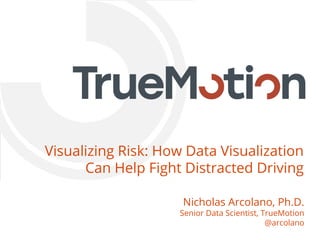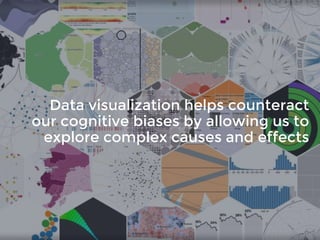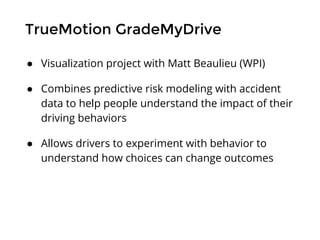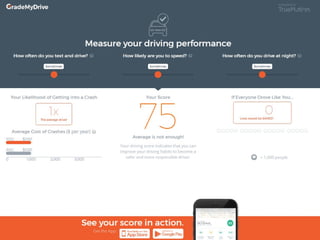Visualizing Risk (2016 Boston Data Visualization Summit)
- 1. Visualizing Risk: How Data Visualization Can Help Fight Distracted Driving Nicholas Arcolano, Ph.D. Senior Data Scientist, TrueMotion @arcolano
- 2. ŌŚÅ Boston-based startup founded in 2012 ŌŚÅ Working to make driving safer and more affordable ŌŚÅ Partnering with auto insurers to provide discounts for safe driving ŌŚÅ Focusing on understanding distracted driving and encouraging behavior change About TrueMotion
- 3. Driving is one of the most dangerous things people do daily
- 4. We use signal processing and machine learning to characterize driver behavior and accident risk ŌŚÅ How much you drive: annual mileage ŌŚÅ When and where you drive: city vs. highway, road conditions, time of day ŌŚÅ How you behave behind the wheel: speeding, acceleration, braking, cornering, and especially distracted driving habits
- 5. Distracted driving dramatically elevates your risk of an accident Drivers who admit to texting while driving1 36% Drivers who actually text while driving2 70% Increase in baseline driving risk due to texting while driving36x 1. State Farm Distracted Driving Survey 2015 2. TrueMotion 2015 field test of 360 drivers / 17,000 trips 3. Dingus et al (2016), Driver crash risk factors and prevalence evaluation using naturalistic driving data
- 7. If distracted driving is so dangerous, then why do we do it?
- 8. LetŌĆÖs take a short detour...
- 9. Behavioral economics ŌŚÅ Why do people make irrational / sub-optimal decisions? ŌŚÅ Biases: information we use to make decisions is often not representative ŌŚÅ Heuristics: we often approximate hard decisions with simpler ones
- 10. Biases and heuristics Optimistic bias / overconfidence ŌŚÅ We often think we have more control over events than we really do (ŌĆ£illusion of controlŌĆØ) ŌŚÅ Thinking we have too much control while driving can lead us to make poor decisions while behind the wheel Availability heuristic ŌŚÅ We estimate true probabilities using the frequencies of our real-world experiences ŌŚÅ By driving without getting into an accident, we believe driving is less risky than it actually is
- 11. TrueMotionŌĆÖs goal: to get people to think differently about the risks of distracted driving
- 12. Data visualization helps counteract our cognitive biases by allowing us to explore complex causes and effects
- 13. Data visualization can help us to... ŌŚÅ Show drivers how individual choices aggregate into long-term behavior ŌŚÅ Help drivers understand how their actions affect their risk of an accident ŌŚÅ Illustrate how changes in risk equate to real-world consequences
- 14. TrueMotion distraction insights and context
- 15. What about understanding long-term accident risk?
- 16. Years You Have Left to Live, Probably http://flowingdata.com/2015/09/23/years-you-have-left-to-live-probably/
- 17. How You Will Die http://flowingdata.com/2016/01/19/how-you-will-die/
- 18. How Other People Die http://flowingdata.com/2016/01/05/causes-of-death/
- 19. TrueMotion GradeMyDrive ŌŚÅ Visualization project with Matt Beaulieu (WPI) ŌŚÅ Combines predictive risk modeling with accident data to help people understand the impact of their driving behaviors ŌŚÅ Allows drivers to experiment with behavior to understand how choices can change outcomes
- 23. Ongoing work ŌŚÅ Real-time feedback of driving risk (based on behavior, traffic, road conditions) ŌŚÅ Modeling and visualization of risk habits: understanding when, where, and why you take your biggest risks ŌŚÅ Relative risk: modeling and visualizing how your choices and risk compare to drivers like you
- 24. THANK YOU!
























